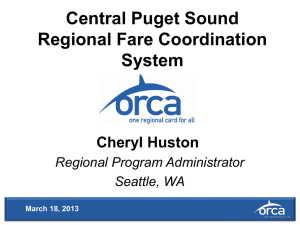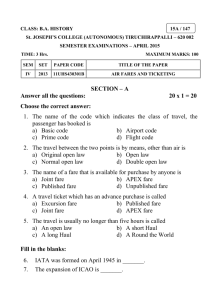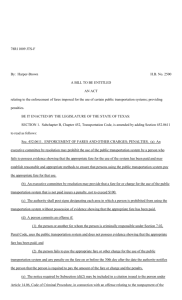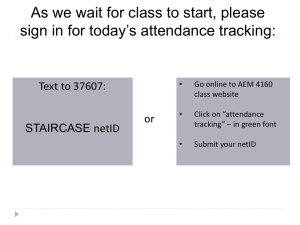SPRING 2015 AEM 4160: Strategic Pricing Prof. Jura Liaukonyte
advertisement
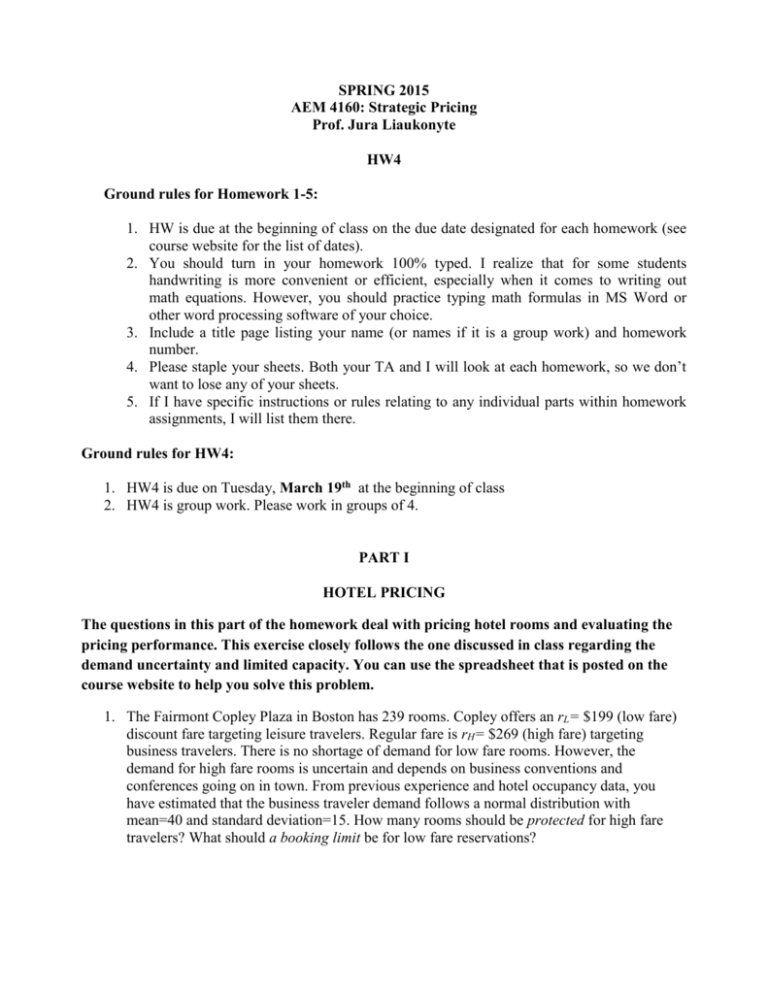
SPRING 2015 AEM 4160: Strategic Pricing Prof. Jura Liaukonyte HW4 Ground rules for Homework 1-5: 1. HW is due at the beginning of class on the due date designated for each homework (see course website for the list of dates). 2. You should turn in your homework 100% typed. I realize that for some students handwriting is more convenient or efficient, especially when it comes to writing out math equations. However, you should practice typing math formulas in MS Word or other word processing software of your choice. 3. Include a title page listing your name (or names if it is a group work) and homework number. 4. Please staple your sheets. Both your TA and I will look at each homework, so we don’t want to lose any of your sheets. 5. If I have specific instructions or rules relating to any individual parts within homework assignments, I will list them there. Ground rules for HW4: 1. HW4 is due on Tuesday, March 19th at the beginning of class 2. HW4 is group work. Please work in groups of 4. PART I HOTEL PRICING The questions in this part of the homework deal with pricing hotel rooms and evaluating the pricing performance. This exercise closely follows the one discussed in class regarding the demand uncertainty and limited capacity. You can use the spreadsheet that is posted on the course website to help you solve this problem. 1. The Fairmont Copley Plaza in Boston has 239 rooms. Copley offers an rL= $199 (low fare) discount fare targeting leisure travelers. Regular fare is rH= $269 (high fare) targeting business travelers. There is no shortage of demand for low fare rooms. However, the demand for high fare rooms is uncertain and depends on business conventions and conferences going on in town. From previous experience and hotel occupancy data, you have estimated that the business traveler demand follows a normal distribution with mean=40 and standard deviation=15. How many rooms should be protected for high fare travelers? What should a booking limit be for low fare reservations? 2. Suppose the manager of the hotel wants to figure out how the optimal protection level (for high demand travelers) varies with changes in price of the high fare (keeping the low fare constant). Fill in the blanks of the following table (reproduce your own table in Excel). Distribution Mean 40 40 40 40 40 40 40 40 40 40 40 40 40 40 St. Dev. 15 15 15 15 15 15 15 15 15 15 15 15 15 15 High Price 209 219 229 239 249 259 269 279 289 299 309 319 329 339 Low Price 199 199 199 199 199 199 199 199 199 199 199 199 199 199 Critical Ratio Number of rooms reserved for high demand customers 3. Graph the relationship between high price (X axis) and Number of rooms reserved for high demand customers (Y axis). Intuitively explain why such relationship holds. 4. Now, instead of varying the high fare, manager wants to see how the optimal protection level changes with respect to the certainty of predicted demand (different levels of standard deviation). Fill in the blanks of the following table (reproduce your own table in Excel). Distribution Mean St. Dev. 40 40 40 40 40 40 40 40 40 5 7.5 10 12.5 15 17.5 20 22.5 25 High Price Low Price 269 269 269 269 269 269 269 269 269 199 199 199 199 199 199 199 199 199 Critical Ratio Number of rooms reserved for high demand customers 5. Graph the relationship between Standard deviation (X axis) and Number of rooms reserved for high demand customers (Y axis). Intuitively explain why such relationship holds. PART II A. Outcome measurement and bundled pricing arrangements in healthcare. Read the following case study “The UCLA Medical Center: Kidney Transplantation”, HBS Case No 9-711-410. Answer the following questions about this case (use your own wording!): 1. Describe UCLA’s bundled reimbursement for kidney transplantation. What are the key choices UCLA has made in constructing the model? How has the reimbursement model contributed to success? 2. How does UCLA measure its progress in kidney transplantation? Has measurement contributed to success? 3. What are the implications of the outcome measurement system and reimbursement approach in organ transplantation for the U.S. health care system as a whole? B. Introduction to Behavioral Biases. Listen to the Freakonomics podcast “When Willpower Isn’t Enough” 1. What were the main results of the gym experiment? 2. Does anyone in your study group engage in what K. Milkman calls “temptation bundling”? Let each member of your team present an example of temptation bundling that they might engage in or might want to aspire to engage in. PART III. Write a blog post. Blog assignment guidelines: http://courses.cit.cornell.edu/jl2545/4160/blogguide4160.htm Also check the blog website www.overtcollusion.com to see examples of good blog posts. IMPORTANT: You have to submit your blog post in two ways: 1) as part of your typed and printed HW# and 2) emailed to your TA mfm88@cornell.edu. Please make sure that the emailed post contains the names of group members. Potential topics of choice for this HW assignment: 1. Pricing Information 2. Online Retailers 3. Advance Sales 4. Overbooking 5. Pricing with Capacity Constraints 6. Behavioral Pricing 7. Other topic that relates to issues we discussed in class. In case you are unsure if your selected topic fits, email me and we will discuss!



